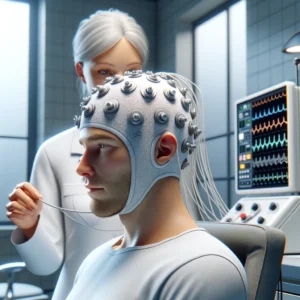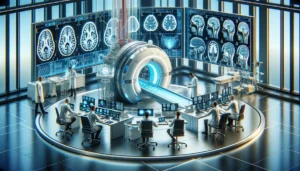Traumatic brain injury (TBI) is a major cause of death and disability worldwide. Millions of people sustain a TBI each year, and about 5.3 million die from it. Various factors, including falls, car accidents, sports injuries, and assaults, can cause TBI. There is no one-size-fits-all treatment for TBI, and the best course of treatment depends on the severity of the injury. However, several advances in TBI research offer hope for better patient outcomes.
The information in this article is for educational and awareness purposes only. If a TBI has impacted you or someone near you, it is critical that medical professionals assess the particular situation and help determine the best course of action.
Biomarkers in TBI Research
One of the most important advances in TBI research is the development of biomarkers. Biomarkers are substances that can be measured in the blood or other tissues to indicate the presence of a disease or injury. In the case of TBI, biomarkers can be used to diagnose the injury, assess the severity of the injury, and track the patient’s recovery.
UCHL-1
One promising biomarker for TBI is ubiquitin C-terminal hydrolase-L1 (UCHL-1). UCHL-1 is an enzyme that is released from damaged neurons after a TBI. The level of UCHL-1 in the blood can be used to measure the injury’s severity and predict the patient’s prognosis.
Ubiquitin C-terminal hydrolase-L1 (UCH-L1) is a protein found in high neuron levels. After a TBI, UCH-L1 is released from damaged neurons and can be detected in the blood. The level of UCH-L1 in the blood can be used to measure the TBI’s severity and predict the patient’s prognosis.
UCH-L1 is a promising biomarker for TBI because it is:
- Sensitive: UCH-L1 levels are elevated in the blood of patients with TBI, even mild TBI.
- Specific: UCH-L1 levels are not elevated in the blood of patients with other conditions, such as stroke or meningitis.
- Timely: UCH-L1 levels can be detected in the blood within hours of a TBI.
UCH-L1 is still under investigation, but it can potentially be a valuable tool for diagnosing and managing TBI.
Here are some additional details about UCH-L1:
- UCH-L1 is an enzyme involved in the breakdown of ubiquitin, a protein used to mark damaged cells for disposal.
- UCH-L1 is released from damaged neurons after a TBI and can be detected in the blood within hours of the injury.
- The level of UCH-L1 in the blood correlates with the TBI’s severity.
- Higher levels of UCH-L1 are associated with a worse prognosis.
UCH-L1 is a promising biomarker for TBI, but it is important to note that it is not a perfect diagnostic tool. Other conditions can cause UCH-L1 levels to be elevated, and the level of UCH-L1 in the blood does not always correlate with the severity of the TBI.
Despite these limitations, UCH-L1 is a valuable tool for diagnosing and managing TBI. It can be used to:
- Diagnose TBI: UCH-L1 levels can help diagnose TBI, especially in cases where the diagnosis is unclear.
- Assess the severity of TBI: UCH-L1 levels can be used to assess the severity of TBI and to predict the patient’s prognosis.
- Monitor the patient’s recovery: UCH-L1 levels can be used to monitor the patient’s recovery and to identify any complications.
GFAP
Another promising biomarker for TBI is glial fibrillary acidic protein (GFAP). GFAP is a protein produced by astrocytes, a brain cell that supports and protects neurons. The level of GFAP in the blood can be used to measure the injury’s severity and track the patient’s recovery.
Glial fibrillary acidic protein (GFAP) is a protein that is produced by astrocytes, a type of cell that supports and protects neurons in the brain. After a traumatic brain injury (TBI), astrocytes become activated and release GFAP into the blood. The level of GFAP in the blood can be used to measure the injury’s severity and track the patient’s recovery.
GFAP is a promising biomarker for TBI because it is:
- Sensitive: GFAP levels are elevated in the blood of patients with TBI, even mild TBI.
- Specific: GFAP levels are not elevated in the blood of patients with other conditions, such as stroke or meningitis.
- Timely: GFAP levels can be detected in the blood within hours of a TBI.
GFAP is still under investigation, but it can be a valuable tool for diagnosing and managing TBI.
Here are some additional details about GFAP:
- GFAP is a structural protein that is found in astrocytes.
- Astrocytes are activated after a TBI and release GFAP into the blood.
- The level of GFAP in the blood is correlated with the severity of the TBI.
- Higher levels of GFAP are associated with a worse prognosis.
GFAP is a promising biomarker for TBI, but it is important to note that it is not a perfect diagnostic tool. There are other conditions that can cause GFAP levels to be elevated, and the level of GFAP in the blood does not always correlate with the severity of the TBI.
Despite these limitations, GFAP is a valuable tool for diagnosing and managing TBI. It can be used to:
- Diagnose TBI: GFAP levels can help diagnose TBI, especially in cases where the diagnosis is unclear.
- Assess the severity of TBI: GFAP levels can be used to assess the severity of TBI and to predict the patient’s prognosis.
- Monitor the patient’s recovery: GFAP levels can be used to monitor the patient’s recovery and to identify any complications.
Other Notable Advances in TBI Research
In addition to biomarkers, several other advances in TBI research offer hope for better patient outcomes. These advances include:
- New methods of imaging the brain. MRI and CT scans are the standard brain imaging methods after a TBI. However, these methods are limited in their ability to detect subtle injuries. New imaging methods, such as diffusion tensor imaging (DTI) and functional MRI (fMRI), are being developed to provide more detailed information about the extent and severity of a TBI.
- New drugs and therapies. Several new drugs and therapies are being developed for the treatment of TBI. These include drugs that protect neurons from damage, drugs that promote the growth of new neurons, and drugs that reduce inflammation.
- New rehabilitation techniques. Rehabilitation is an important part of the treatment for TBI. New rehabilitation techniques are being developed to help patients regain lost function. These techniques include physical therapy, occupational therapy, and speech therapy.
The advances in TBI research offer hope for better outcomes for patients. However, more research is needed to develop effective treatments for TBI. With continued research, it is possible to develop new treatments to help patients recover from a TBI and live full and productive lives.
Additional TBI Research Areas
In addition to the advances mentioned above, a number of other research areas are being pursued to improve outcomes for patients with TBI. And these areas include:
- Understanding the role of inflammation in TBI. Inflammation is a natural response to injury but can also damage brain tissue. Researchers are studying ways to reduce inflammation without compromising the immune system’s ability to fight infection.
- Developing new ways to protect neurons from damage. Researchers are studying ways to increase the production of antioxidants and other substances that protect neurons from damage. They are also studying ways to repair damaged neurons.
- Developing new ways to promote the growth of new neurons. The brain can generate new neurons, even in adults. Researchers are studying ways to stimulate the growth of new neurons after a TBI.
- Developing new ways to improve rehabilitation. Rehabilitation can help patients to regain lost function after a TBI. Researchers are studying new ways to make rehabilitation more effective.
The research in TBI is rapidly evolving, and there is reason to be optimistic about the future. With continued research, it is possible to develop new treatments to help patients recover from a TBI and live full and productive lives.
Institutions
Here are a few leading institutions doing traumatic brain injury research:
- National Institute of Neurological Disorders and Stroke (NINDS): The NINDS is a part of the National Institutes of Health (NIH) and is the leading federal funder of brain research. The NINDS has a dedicated program for TBI research and supports a wide range of research projects, including basic research on the mechanisms of TBI, clinical research on new treatments for TBI, and research on rehabilitation for people with TBI.
- Centers for Disease Control and Prevention (CDC): The CDC is a federal agency that works to protect public health. The CDC’s TBI program conducts research on the epidemiology of TBI, prevention of TBI, and rehabilitation for people with TBI.
- Department of Veterans Affairs (VA): The VA is a federal agency providing veterans healthcare. The VA’s TBI program researches the long-term effects of TBI, rehabilitation for people with TBI, and prevention of TBI in veterans.
- University of Pennsylvania: The University of Pennsylvania has a leading program in TBI research. The Penn Center for Brain Injury Research is one of the largest TBI research centers in the world. The center’s research focuses on basic research on the mechanisms of TBI, clinical research on new treatments for TBI, and research on rehabilitation for people with TBI.
- The University of California, San Francisco (UCSF): UCSF has a leading program in TBI research. The UCSF Brain Injury Research Center is one of the oldest TBI research centers in the world. The center’s research focuses on basic research on the mechanisms of TBI, clinical research on new treatments for TBI, and research on rehabilitation for people with TBI.
These are just a few of the many leading institutions doing TBI research. Many other great institutions are doing important work in this area.






